11.06.2024
The James Webb Space Telescope finds a jeweled ring in the cosmos
A gravitationally lensed quasar looks just like a sparkling piece of jewelry.
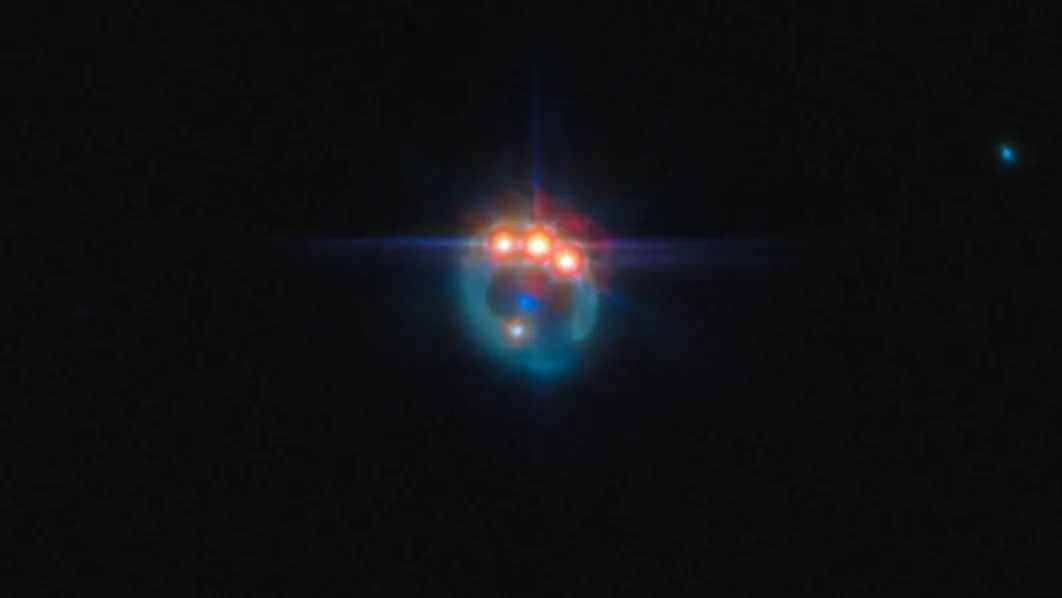
Gravitational lensing from an elliptical galaxy creates an arc with three bright spots on the top representing a duplicate view of a single quasar called RX J1131-1231, located six billion light-years from Earth. (Image credit: ESA/Webb, NASA & CSA, A. Nierenberg)
A sparkling jeweled ring, created through a cosmic phenomenon called gravitational lensing, has been imaged by the James Webb Space Telescope.
The new image captures a distant quasar known as RX J1131-1231, which lies about 6 billion light-years from Earth. The powerful gravitational field of a nearby elliptical galaxy, located in the foreground of the image, warps the light of the quasar — which is an extremely luminous active galactic nucleus (AGN) — creating a bright arc and duplicate views of the object, ultimately procuring a visual that looks like gemstones on a ring.
Quasars are powered by large amounts of gas and dust falling into a galaxy's supermassive black hole, causing the region to shine very brightly. The effects of gravitational lensing, which occurs when a massive object, like a galaxy, bends the light from a more distant source, allow astronomers to study regions close to the black hole part of distant quasars, according to a statement from the European Space Agency (ESA).
"Measurements of the X-ray emission from quasars can provide an indication of how fast the central black hole is spinning and this gives researchers important clues about how black holes grow over time, "ESA officials said in the statement.
The elliptical galaxy creating the gravitational lens in the new JWST imageappears as a small blue dot in the center of the ring. The galaxy acts as a natural telescope, magnifying the light from the more distant quasar, which is otherwise too far away to study.
"If a black hole grows primarily from collisions and mergers between galaxies, it should accumulate material in a stable disc, and the steady supply of new material from the disc should lead to a rapidly spinning black hole," ESA officials said in the statement. "On the other hand, if the black hole grew through many small accretion episodes, it would accumulate material from random directions. Observations have indicated that the black hole in this particular quasar is spinning at over half the speed of light, which suggests that this black hole has grown via mergers, rather than pulling material in from different directions."
The new image was taken using the JWST's Mid-Infrared Instrument (MIRI) as part of a larger study of dark matter and its distribution in the universe. With these recent observations, and previous views from other telescopes, RX J1131-1231 is considered one of the best lensed quasars discovered to date.
Quelle: SC
----
Update: 16.07.2024
.
Is the James Webb Space Telescope really 'breaking' cosmology?
The truth is much more nuanced — and much more interesting.
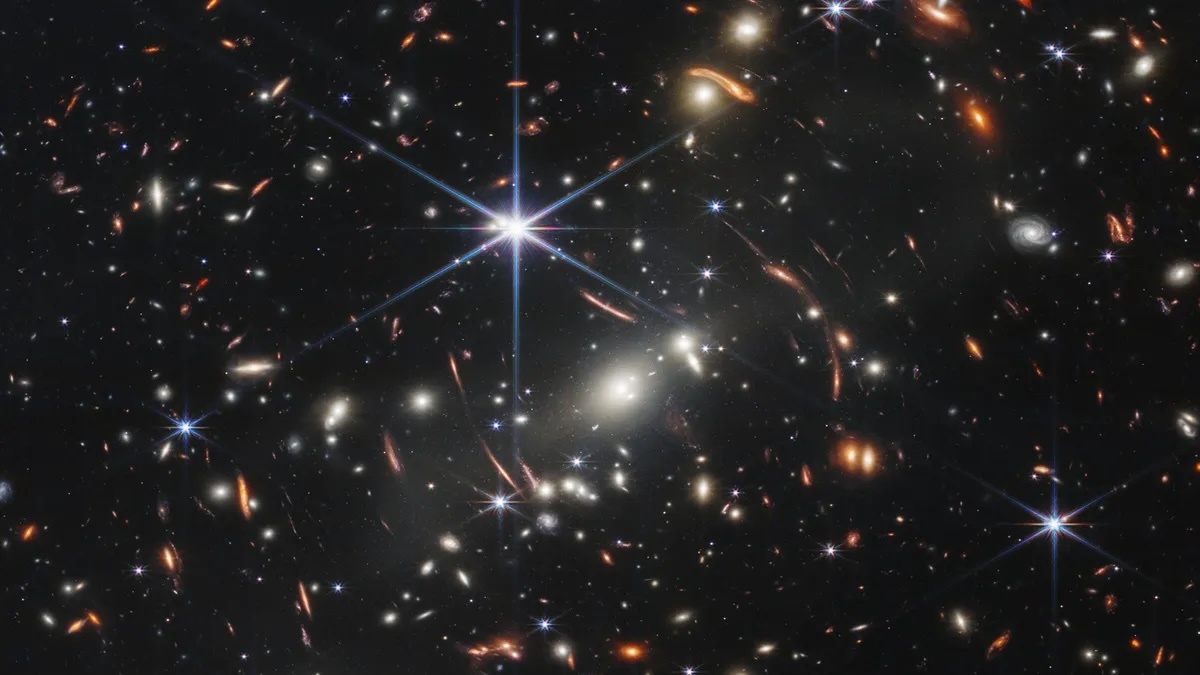
The James Webb Space Telescope deep field image showing some of the earliest and most distant galaxies ever seen. (Image credit: NASA, ESA, CSA, and STScI)
Not long after the James Webb Space Telescope (JWST) began its science operations, astronomers announced that they had discovered galaxies in the early universe that were far too large, bright and full of stars for their age. While headlines around the world claimed that these galaxies were "breaking" our understanding of the Big Bang, the truth is much more nuanced — and much more interesting.
The Big Bang theory is our general picture of the history of the universe, starting in its deep past, when the cosmos was much smaller, hotter and denser than it is today. This model, initially developed in the early 20th century, has survived a battery of observational tests and is extremely good at explaining a variety of cosmological observations, including the redshifting of light from distant galaxies, the appearance of leftover radiation in the form of the cosmic microwave background, the abundances of light elements, and the evolution of galaxies and larger structures.
While the Big Bang theory can't say for certain which galaxies will appear where, it can talk about probabilities. For example, cosmologists can say roughly how many small galaxies, how many medium galaxies and how many large galaxies should appear in a given volume at a certain age of the universe. But until JWST, we did not have direct observational access to the earliest stages of galactic evolution — something the telescope was explicitly designed to study.
In 2022, astronomers announced that they had found extremely distant galaxies that were surprisingly, weirdly large. They had measured the redshift of the galaxies to be over 16, implying that these galaxies existed just 200 million to 250 million years after the Big Bang. Yet they were gigantic and appeared to be fully formed, with spiral arms and everything.
These galaxies seemed far outside the expectations of the Big Bang theory; they were like finding teenagers in a kindergarten classroom. So what was going on?
Bending cosmology
Cue the brazen headlines proclaiming the death of the Big Bang theory. But those stories left out a crucial detail: Astronomers estimated the redshift of those galaxies through a technique known as photometry, which is incredibly uncertain. A full evaluation of the ability of those galaxies to "break" cosmology would have to wait for a more precise measurement of their redshift, and hence their age.
When those more precise measurements finally came a few months later, those galaxies turned from record-shattering to just … normal galaxies. For example, one galaxy's redshift was revised from over 16 to just 4.9, moving its age from 240 million years after the Big Bang to well over a billion years. That's more than enough time for the normal Big Bang theory to explain their sizes and shapes.
But along with those less-exciting revisions came some new confirmed redshifts of other galaxies, including JADES-GS-z14-0, the current most distant known galaxy, with a redshift of 14.32. This galaxy was alive and well when the cosmos was just 290 million years old.
Astronomers fully expected galaxies to exist 290 million years after the Big Bang; that's why they built JWST. And as galaxies go, JADES-GS-z14-0 is certainly a juvenile — it's only 1,600 light-years across, compared with the Milky Way's 100,000 light-years. But interestingly, the galaxy is rather bright and full of stars— not enough to outright break cosmology, but enough to open up some questions about the origins and development of the first galaxies to appear in the universe.
Building cosmology
It's quite possible that the Big Bang theory is wrong; scientists must maintain the mental discipline to admit the possibility. But with such a wealth of evidence behind it, the Big Bang is unlikely to be unseated from a single observation. And it's worth reiterating that JWST is doing exactly what we designed and built it to do: answer some major lingering questions about how the first stars and galaxies appeared.
It's entirely possible that cosmologists will be able to explain the appearance of galaxies like JADES-GS-z14-0 within the framework of the Big Bang without having to make any major revisions. For example, large black holes may have appeared before these galaxies did, and their superpowered gravitational attraction may have triggered bright bursts of star formation. Or perhaps supernova feedback and other mechanisms caused the first galaxies to be richer with stars than present-day galaxies, making those early galaxies appear mighty despite their small size.
Or maybe our initial observations are biased toward these small-but-bright outliers and further campaigns will reveal larger populations of more mundane galaxies, thus reducing the tension with galaxy formation models.
And lastly, perhaps we need to add some new ingredient to the universe, like allowing for dark energy to evolve with time, to produce these kinds of galaxies at such early times.
This is exciting enough on its own, without the need to upend the Big Bang as we know it. There are more than enough mysteries and hidden corners within the universe to keep astronomers up at night wondering about the possibilities — and up in the morning to keep working on how to solve them.
Quelle: SC
----
Update: 17.07.2024
.
Can the James Webb Space Telescope see galaxies over the universe's horizon?
How can any telescope see a galaxy 33.8 billion light-years away in a universe that is only 13.8 billion years old?
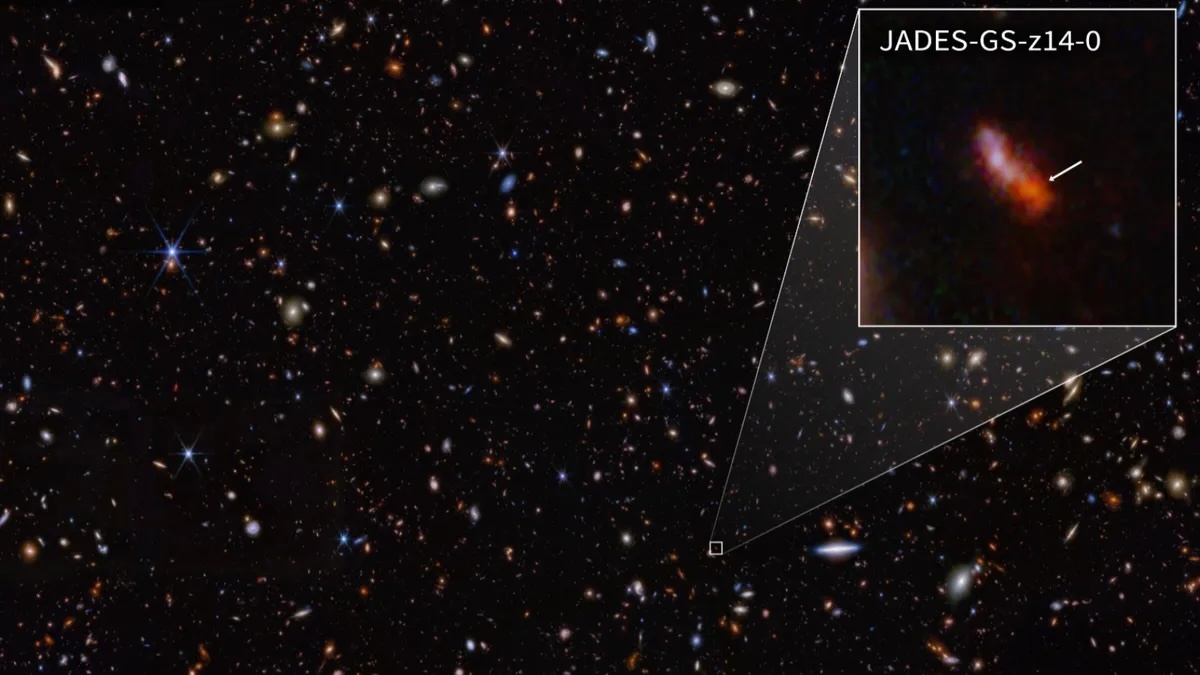
The galaxy JADES-GS-z14-0 which exists 33.8 billion light-years from Earth. (Image credit: NASA, ESA, CSA, STScI, Brant Robertson (UC Santa Cruz), Ben Johnson (CfA), Sandro Tacchella (Cambridge), Phill Cargile (CfA))
Since it began sending data back to Earth in 2022, the James Webb Space Telescope (JWST) has greatly impacted astronomy, and one of its most revolutionary achievements is the observation of some of the most distant galaxies ever seen. However, because light doesn't travel instantly — but rather moves at about 300 million meters (985 million feet) per second in a vacuum — we don't see those galaxies as they are today, but as they were billions of years ago.
Moreover, our universe is estimated to be 13.8 billion years old. So, we should assume that the most distant galaxy we could ever hope to see is no more than 13.8 billion light-years away. (One light-years is the distance light travels in a year). That point should be a "cosmological horizon" of sorts — beyond which no telescope should be able to see. And, because nothing can travel through space faster than c, that means there should be no way a galaxy further than 13.8 billion light years away, and getting more distant all the time could affect Earth. Right?
Wrong. If only the universe were that simple.
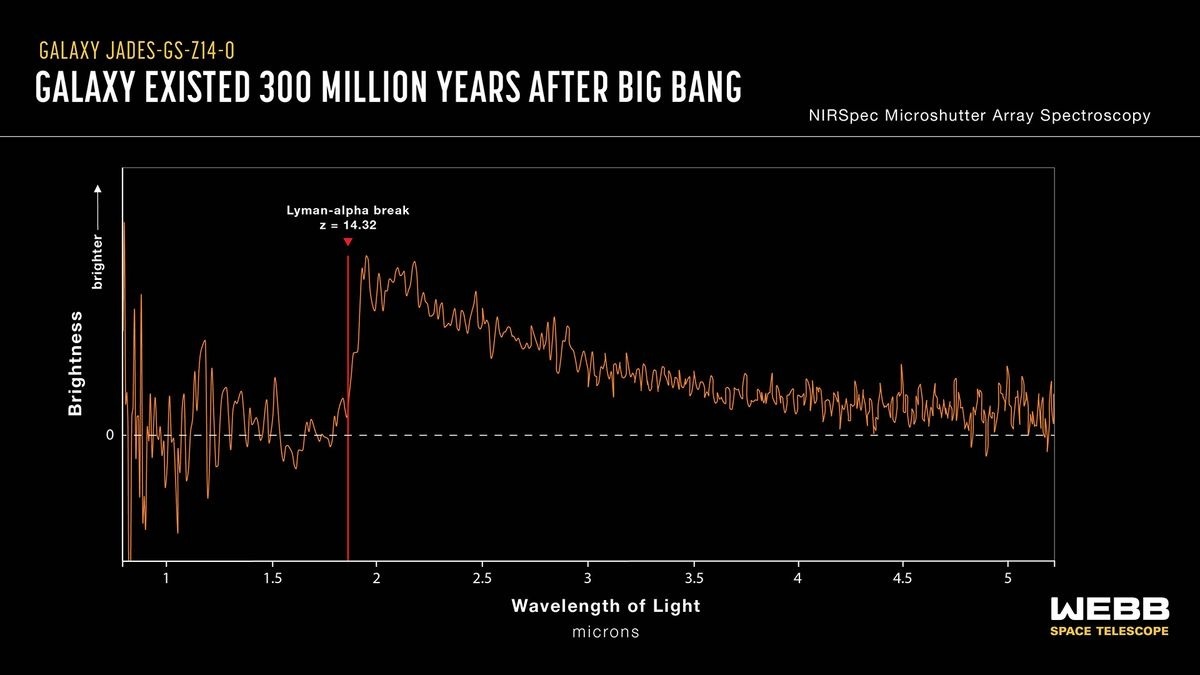
The redshifted spectrum of JADES-GS-z14-0 as measured by the JWST's NIRSpec instrument (Image credit: NASA, ESA, CSA, J. Olmsted (STScI). Science: S. Carniani (Scuola Normale Superiore), JADES Collaboration.)
"A cosmological horizon is a maximum distance from which one could possibly retrieve information," Jake Helton, a University of Arizona astronomer who is also part of the JWST Advanced Deep Extragalactic Survey (JADES) team, told Space.com.
"There are a few different cosmological horizons," Helton continued, "which have different definitions and depend on various cosmological quantities. The most relevant here is the cosmological horizon which is the maximum distance from which light could have traveled to us in the age of the universe. This defines
the edge of the observable cosmos."
In March of 2024, JADES scientists revealed the powerful telescope had spotted JADES-GS-z14-0, the most distant and early galaxy humanity has ever seen. The paradox, however, is that JADES-GS-z14-0 is located about 33.8 billion light years away.
How can we see light from an object so distant the universe isn't old enough to have allowed it to have reached us? Doesn't JADES-GS-z14-0's position 33.8 billion light-years away mean we see it as it was 33.8 billion years ago, something that would surely challenge the estimation of the age of the universe?
Not so. Again, this is evidence that the universe has a way of turning sensible and logical conclusions on their heads.
"How can a distant galaxy like JADES-GS-z14-0 ever be observed, since it is more than 13.8 billion light years away from us and its light seemingly would have taken more time than the age of the universe to reach us?" Helton asked rhetorically. "The answer is the expansion of the universe."
Seeing a galaxy older than time itself
If the universe would just sit still, then light from a galaxy 33.8 billion light-years away would take 33.8 billion years to reach us, and that would be that. But, in the early 1900s, Edwin Hubble found that distant galaxies appeared to be receding away from each other, and the further apart they were, the faster they were going. In other words, the universe isn't static; it is expanding.
This was further complicated in 1998, as the 20th century drew to a close when two separate teams of astronomers observed that, not only is the universe expanding, but that expansion is also accelerating. The force responsible is a mystery, but it has been given the placeholder name of "dark energy."

A diagram showing the expansion of the the universe at first due to the Big Bang and then at an acceleration rate when dark energy took over. (Image credit: NASA / WMAP Science Team)
There are two major and distinct periods of expansion over the 13.8 billion-year history of the universe. The first is an initial period of rapid cosmic inflation that is now commonly called the "Big Bang."
This inflationary epoch saw the volume of the cosmos increase by a factor of 10^26 (10 followed by 25 zeroes). That is equivalent to your fingernail going from growing at 1 nanometer per second to suddenly growing 10.6 light-years (62 trillion miles) long. At this time, the universe was dominated by energy, and this period is known as the energy-dominated epoch.
This was followed by a matter-dominated epoch beginning 47,000 years after the Big Bang. Eventually, universal expansion allowed the cosmos to cool enough to allow protons to form from quarks and gluons, and then protons to bond with electrons to form the first atoms of hydrogen, which formed the first stars and galaxies. During this period, the Big-Bang-driven expansion of the universe slowed to a near halt.
The matter-dominated epoch came to a surprising end when the universe was just under 10 billion years old. At this time, the universe suddenly began to expand rapidly yet again. Plus, that expansion got faster and faster and even continues to accelerate today. This third significant period of the universe is called the dark-energy-dominated epoch. It's the epoch we're currently in.
Thanks to these periods of expansion of the universe, the light from JADES-GS-z14-0 has only actually been traveling to the JWST and Earth for 13.5 billion years, despite its source now being much more distant than 13.5 billion light-years away. That means the JWST sees JADES-GS-z14-0 as it was 300 million years after the Big Bang. Without the expansion of the universe, JADES-GS-z14-0 would still be around 13.5 billion light-years away, though it would have still experienced smaller local motions that could have moved it closer together or further from nearby galaxies. But such galactic movement would've been nowhere near the kind caused by the expansion of the universe.
According to Helton, the cosmological horizon, or the "Photon Horizon," is a sphere with a boundary around 46.1 billion light years away, a figure dictated by the universe's expansion. This is the actual horizon beyond which we shouldn't be able to "see" a galaxy. The galaxy JADES-GS-z14-0 is indeed within that horizon.
To avoid confusion, astronomers actually use two distance measurement scales: a co-moving distance that eliminates the expansion of the universe as a factor and a proper distance that includes it. That means the co-moving distance of JADES-GS-z14-0 is 13.5 billion light-years, while its proper distance is 33.8 billion light-years.
JADES-GS-z14-0 and other distant and ancient galaxies won't always be visible, though.
A lucky era to have the James Webb Space Telescope
The fact that the JWST can see JADES-GS-z14-0 means it was once "causally connected" to Earth and our local universe. In other words, it was possible for a signal from JADES-GS-z14-0 to reach us in the Milky Way, thus a "cause" in this galaxy that existed at the dawn of time could have an "effect" in our galaxy in this modern epoch of the cosmos.
"Any observable galaxy must be within the particle horizon and must have been causally connected with us at some point in the history of the universe," Helton said.
This isn't the case anymore, however. Galaxies like JADES-GS-z14-0 and the other JADES-discovered galaxies are now so distant and are driven away from us so rapidly, thanks to dark energy, that no signal from them sent today could ever reach us. That's because the photon horizon moves away from us at the speed of light, but for really distant objects, the space between the Milky Way and those galaxies is expanding faster than the speed of light.
This might seem implausible, as Albert Einstein's theory of special relativity sets the speed of light as a universal speed limit. However, that is a rule for objects with mass moving through space, not a rule for the very fabric of space itself.
In around 2 trillion years after Earth and humanity are long gone, the expansion of the universe means that, whatever intelligent species replaces us in the Milky Way (if one ever does), will be unable to see any galaxies that exist beyond our local group — which has a diameter of around 10 million light-years.
It is a sobering thought, and it means humanity lives at a unique point in the history of the universe at which the most distant galaxies are still within our view. We are capable of knowing more about the universe and its origins than any intelligent life that may follow us. Astronomers, including Helton, intend to use the JWST to fully exploit this cosmic privilege.
"Working with JWST and the JADES Collaboration has been incredible," Helton said. "Writing papers about science with JWST, like my recent one on
JADES-GS-z14-0, has been the most rewarding and exciting experience
of my research career."
Quelle: SC
----
Update: 25.07.2024
.
Alien weather report: James Webb Space Telescope detects hot, sandy wind on 2 brown dwarfs
Coarse clouds of hot sand blow in the powerful winds of these two failed stars.
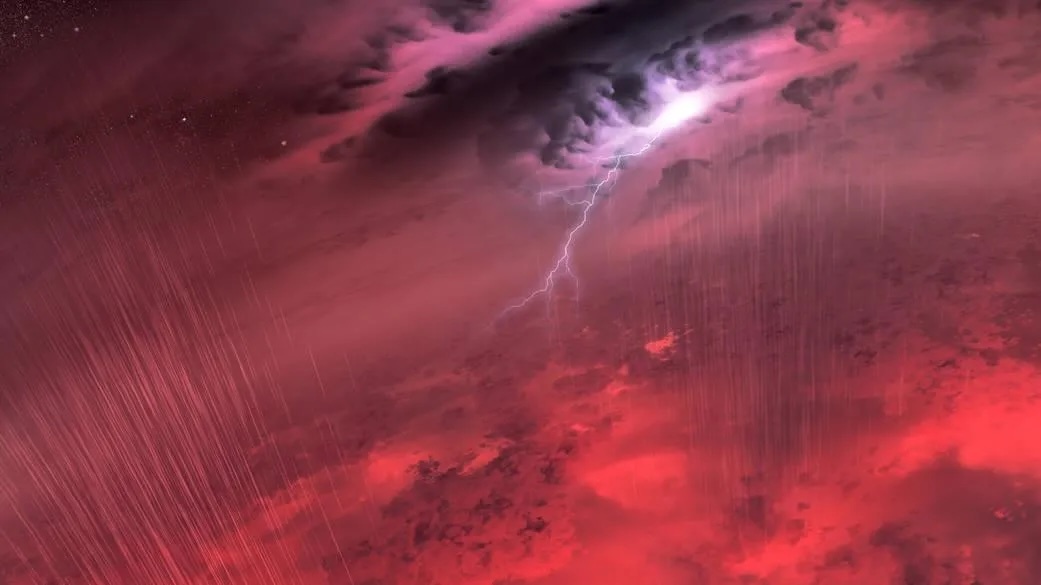
An illustration of the powerful storms and clouds of silicate found in the atmosphere of the brown dwarfs.(Image credit: NASA/JPL–Caltech/University of Western Ontario/Stony Brook University/Tim Pyle)
The James Webb Space Telescope (JWST) has discovered stormy weather in the sky of two brown dwarfs in the most detailed weather report yet from such "failed stars."
The two brown dwarfs form a binary pair called WISE 1049AB that was discovered by NASA's Wide-field Infrared Survey Explorer (WISE) in 2013; the duo sits just 6.5 light-years away from us. They are the closest brown dwarfs to our sun, and thus make an excellent target for the James Webb Space Telescope's powerful infrared instruments.
A brown dwarf is an object that isn't quite massive enough to ignite the nuclear fusion of hydrogen to helium in its core and become a fully fledged star — yet is also considered too massive to be a planet and thought to form like stars do (via the gravitational collapse of a cloud of molecular gas). As such, brown dwarfs are thought of as a missing link between gas giant planets like Jupiter, and the lowest mass stars, M-dwarfs.
Previous observations have probed the atmosphere of various brown dwarfs, but they have always been limited to time-averaged snapshots, meaning we could not see things in the brown-dwarf atmosphere changing with time. However, brown dwarfs are fast rotators — WISE 1049A spins on its axis once every 7 hours, and B once every 5 hours — and the conditions in their atmospheres can alter over time, meaning that previous observations that didn't factor in the objects' evolutions could have missed lots of variability.
The JWST, however, does have the ability to detect these changes over time. A team led by Beth Biller of the University of Edinburgh observed WISE 1049AB for 8 hours with the JWST's Mid-Infrared Instrument (MIRI), and then immediately afterward for another 7 hours with its Near-Infrared Spectrometer (NIRSpec).
The researchers found that both brown dwarfs are covered in tumultuous clouds, probably composed of silicate grains, sweltering in temperatures between 875 degrees Celsius (1,610 degrees F) and 1,026 degrees Celsius (1880 degrees F). In other words, hot sand is being blown in the winds of the brown dwarfs. The absorption signatures of carbon monoxide, methane and water vapor were also identified.
Intriguingly, the light curve for each brown dwarf (a graph of each brown dwarf's brightness over time) displays considerable variability. This has been interpreted as stormy conditions blowing clouds at various altitudes, and gaps appearing between those clouds that allows for views into deeper layers of the atmosphere. The light curves also show peaks at specific wavelengths — carbon monoxide at 2.3 microns and 4.2 microns (millionths of a meter), methane at 3.3 microns, and silicate grains tentatively at 8.3 microns to 8.5 microns.
Biller's team interpret the peaks at these wavelengths as indicating three different layers where there is a significant change in atmospheric pressure on each brown dwarf. There's a deep layer producing signals greater than 2.3 microns but less than 8.5 microns, an intermediate altitude layer absorbing light at between 2.3 and 4.2 microns, and a high altitude layer with exhibiting signals between 4.2 and 8.5 microns.
The findings indicate the power of the JWST to be able to probe, for the first time, the vertical profile (i.e. the conditions at different depths) of the atmosphere of a brown dwarf, and, in fact, there's no reason the JWST has to stop there. As the research paper describing the findings concludes: "This is the first such study, but will not be the last — in the next few observing cycles, JWST will transform our understanding of both brown dwarf and young, giant exoplanet atmospheres."
"Our findings show that we are on the cusp of transforming our understanding of worlds far beyond our own," said Biller in a statement. "Insights such as these can help us understand the conditions not just on celestial objects like brown dwarfs, but also on giant exoplanets beyond our solar system. Eventually, the techniques we are refining here may enable the first detections of weather on habitable planets like our own, which orbit other stars."
The findings were published on July 15 in the Monthly Notices of the Royal Astronomical Society.
Quelle: SC
----
Update: 25.07.2024
.
Webb images nearest super-Jupiter, opening a new window to exoplanet research
The coldest and oldest exoplanet ever imaged agrees with models of planet evolution to solar system ages
Using the James Webb Space Telescope (JWST), an MPIA-led team of astronomers imaged a new exoplanet that orbits a star in the nearby triple system Epsilon Indi. The planet is a cold super-Jupiter exhibiting a temperature of around 0 degrees Celsius and a wide orbit comparable to that of Neptune around the Sun. This measurement was only possible thanks to JWST’s unprecedented imaging capabilities in the thermal infrared. It exemplifies the potential of finding many more such planets similar to Jupiter in mass, temperature, and orbit. Studying them will improve our knowledge of how gas giants form and evolve in time.
“We were excited when we realised we had imaged this new planet”, said Elisabeth Matthews, a researcher at the Max Planck Institute for Astronomy in Heidelberg, Germany. She is the main author of the underlying research article published in the journal Nature. “To our surprise, the bright spot that appeared in our MIRI images did not match the position we were expecting for the planet”, Matthews points out. “Previous studies had correctly identified a planet in this system but underestimated this super-Jupiter gas giant’s mass and orbital separation”. With the help of JWST, the team was able to set the record straight.
This detection is quite unusual in several aspects. It shows the first exoplanet imaged with JWST that had not already been imaged from the ground and is much colder than the gas planets JWST has studied so far. An ‘image’ means that the planet appears as a bright dot on the images and thus represents direct evidence. The transit and radial velocity methods are indirect evidence, as the planet only reveals itself through its mediated effect.
JWST observations update previous measurements
The planet revolves around the main component of the nearby triple star system Epsilon Indi, or Eps Ind for short. Astronomical labelling conventions assign the label Eps Ind A to that primary star, a red dwarf star a little smaller and cooler than the sun. To construct the planet’s name, a “b” is appended, resulting in the designation Eps Ind Ab.
The new JWST data are consistent with a super-Jupiter having a mass six times that of Jupiter in the Solar System. Eps Ind Ab orbits its host star on an eccentric, elliptical orbit whose farthest separation from Eps Ind A should range between 20 and 40 astronomical units. One astronomical unit is the mean distance between Earth and the Sun, approximately 150 million kilometres. The new values differ considerably from earlier studies, which is why the team chose to call this a “new” planet.
Cool planets, hot science
Only a few cold gas-giant planets orbiting solar-age stars are known to date, and these have all been inferred indirectly from radial velocity measurements. By imaging and taking spectra of the planets, astronomers can study their atmospheres and trace the evolution of planetary systems compared to computational models. Studying planets in fully settled planetary systems helps tie up loose ends concerning the late stages of planetary evolution and refine our general understanding of planet formation and evolution.
The recent observations lead the way to finding many more of these cold gas-giant planets. These will allow astronomers to study a new class of exoplanets and compare them to the solar system gas giants.
How to detect cold gas planets
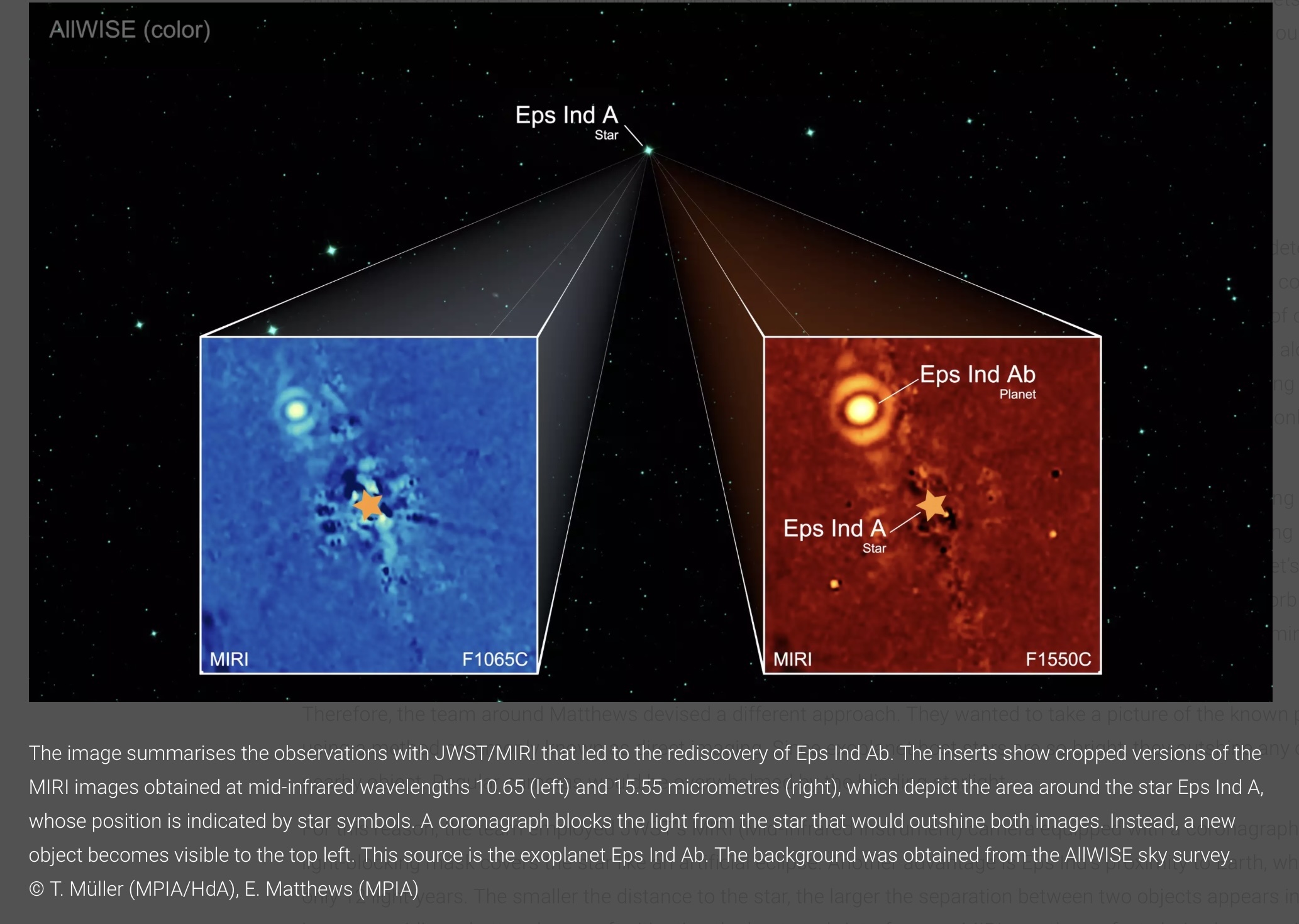
However, these planets are hard to find using the classical detection methods. Planets far from their host stars are typically very cold, unlike the hot Jupiters that circle their stars at separations of only a few stellar radii. Wide orbits are highly unlikely to be aligned along the line of sight to produce a transit signal. In addition, measuring their signals with the radial-velocity method is challenging when only a small section of the orbit can be monitored.
Earlier studies attempted to investigate a giant planet orbiting Eps Ind A using radial velocity measurements. However, extrapolating a small part of the orbit led to incorrect conclusions about the planet’s properties. After all, Eps Ind Ab needs around 200 years to orbit its star. Observations over a few years are insufficient to determine the orbit with high precision.
Therefore, the team around Matthews devised a different approach. They wanted to take a picture of the known planet using a method commonly known as direct imaging. Since exoplanet host stars are so bright, they outshine any other nearby object. Regular cameras would be overwhelmed by the blinding starlight.
For this reason, the team employed JWST’s MIRI (Mid-Infrared Instrument) camera equipped with a coronagraph. This light-blocking mask covers the star like an artificial eclipse. Another advantage is Eps Ind’s proximity to Earth, which is only 12 light-years. The smaller the distance to the star, the larger the separation between two objects appears in an image, providing a better chance of mitigating the host star’s interference. MIRI was the perfect choice because it observes in the thermal or mid-infrared, where cold objects shine brightly.
What do we know about Eps Ind Ab?
“We discovered a signal in our data that did not match the expected exoplanet,” says Matthews. The point of light in the image was not in the predicted location. “But the planet still appeared to be a giant planet,” adds Matthews. However, before being able to make such an assessment, the astronomers had to exclude the signal was coming from a background source unrelated to Eps Ind A.
“It is always hard to be certain, but from the data, it seemed quite unlikely the signal was coming from an extragalactic background source,” explains Leindert Boogaard, another MPIA scientist and a co-author of the research article. Indeed, while browsing astronomical databases for other observations of Eps Ind, the team came across imaging data from 2019 obtained with the VISIR infrared camera attached to the European Southern Observatory’s (ESO) Very Large Telescope (VLT). After re-analysing the images, the team found a faint object precisely at the position where it should be if the source imaged with JWST belonged to the star Eps Ind A.
The scientists also attempted to understand the exoplanet atmosphere based on the available images of the planet in three colours: two from JWST/MIRI and one from VLT/VISIR. Eps Ind Ab is fainter than expected at short wavelengths. This could indicate substantial amounts of heavy elements, particularly carbon, which builds molecules such as methane, carbon dioxide, and carbon monoxide, commonly found in gas-giant planets. Alternatively, it might indicate that the planet has a cloudy atmosphere. However, more work is needed to reach a final conclusion.
Plans and prospects
This work is only a first step towards characterising Eps Ind Ab. “Our next goal is to obtain spectra which provide us a detailed fingerprint of the planet’s climatology and chemical composition,” says Thomas Henning, Emeritus Director at MPIA, co-PI of the MIRI instrument, and a co-author of the underlying article.
“In the long run, we hope to also observe other nearby planetary systems to hunt for cold gas giants that may have escaped detection,” says Matthews. “Such a survey would serve as the basis for a better understanding of how gas planets form and evolve.”
Background information
The MPIA scientists involved in this study are Elisabeth Matthews, Leindert Boogaard, and Thomas Henning.
Other researchers include Aarynn Carter (Space Telescope Science Institute, Baltimore, USA), Caroline Morley (University of Texas at Austin, Austin, USA), and Prashant Pathak (Indian Institutes of Technology, Kanpur, India).
The MIRI consortium consists of the ESA member states Belgium, Denmark, France, Germany, Ireland, the Netherlands, Spain, Sweden, Switzerland, and the United Kingdom. The national science organisations fund the consortium’s work – in Germany, the Max Planck Society (MPG) and the German Aerospace Center (DLR). The participating German institutions are the Max Planck Institute for Astronomy in Heidelberg, the University of Cologne, and Hensoldt AG in Oberkochen, formerly Carl Zeiss Optronics.
JWST is the world’s premier space science observatory. It is an international program led by NASA jointly with its partners, ESA (European Space Agency) and CSA (Canadian Space Agency).
Quelle: Max-Planck-Gesellschaft
